North American 5-15, 5-20, 6-15, & 6-20, and Japanese JIS 8303 Hospital-Grade Cords
Posted on 6/26/23 4:18 PM
Safe & Reliable Is Now Safer with Cord Clips.
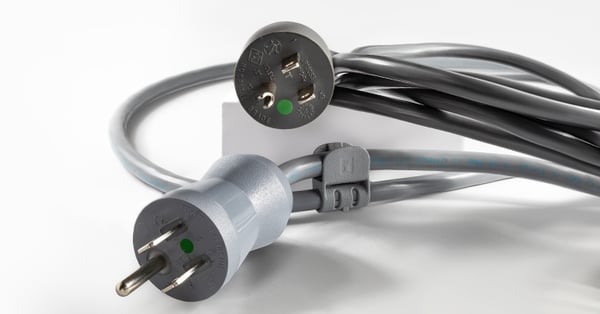
For over a century, AC power has played a vital role in the welfare of patients and staff in hospitals and clinics worldwide. Hospital-grade electrical cords are designed to provide the correct amperages and voltages for a broad range of medical equipment—portable CT Scanners and X-ray machines to heart monitors, ECMO machines, and hospital-grade treadmills. Hospital-grade certified by a “green dot,” Interpower North American (NEMA) 5-15, 5-20, 6-15, and 6-20 hospital-grade molded and hand-wired cords and cord sets provide consistent electrical continuity on the inside while offering rugged durability on the outside. The green dot is also found on the Japanese JIS 8303 plug, which meets JIS T 1021 hospital-grade standards.
The retention devices Interpower uses are stainless steel rings in molded hospital-grade cords and clamped strain reliefs in hand-wired hospital-grade cords to ensure electrical continuity—the bunched conductors remain solidly in place.
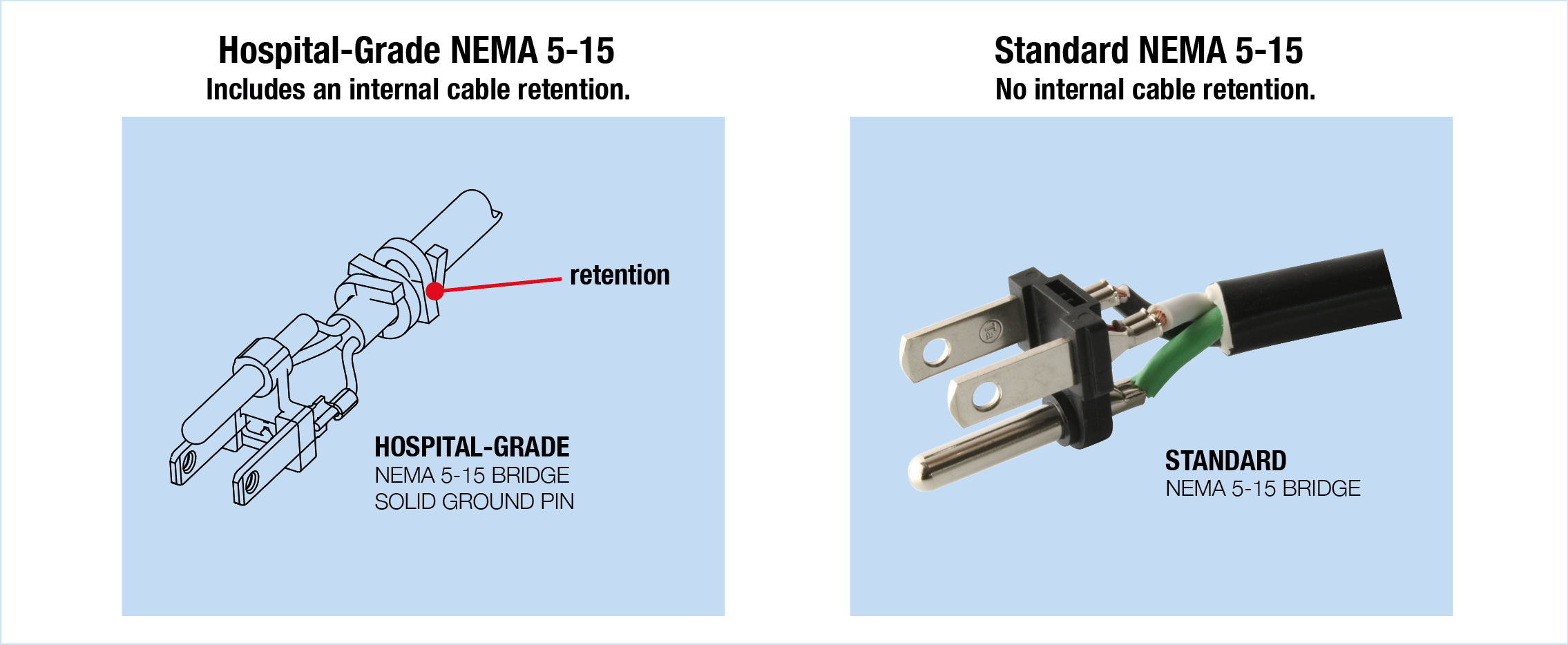
Hospital-Grade Standards Overview
Country-specific agencies such as UL have created—and keep creating—additional safety standards through testing methodologies enhanced from existing household cord standards, i.e., what metals and existing or breakthrough resins should be used for the more robust hospital-grade plugs? What lengths should their blades and pins be? What are the amperage and voltage ratings of the cord set? Besides their own agency standards, countries may also recognize IEC standards. Countries that do not use hospital-grade standards use their existing household cord standards for medical equipment and devices.
In Australia, for example, hospital-grade cords must meet AS/NZS 3200 standards, and for plugs AS/NZS 3112. An Australian rewirable 3-pin plug must be clear or “see-through.” For molded plugs clear or colored is optional. The preference for many Australian hospitals is orange cable terminated in a clear plug.
| Molded Australian Hospital-Grade Plugs | Rewirable Australian Hospital-Grade Plugs |
|---|---|
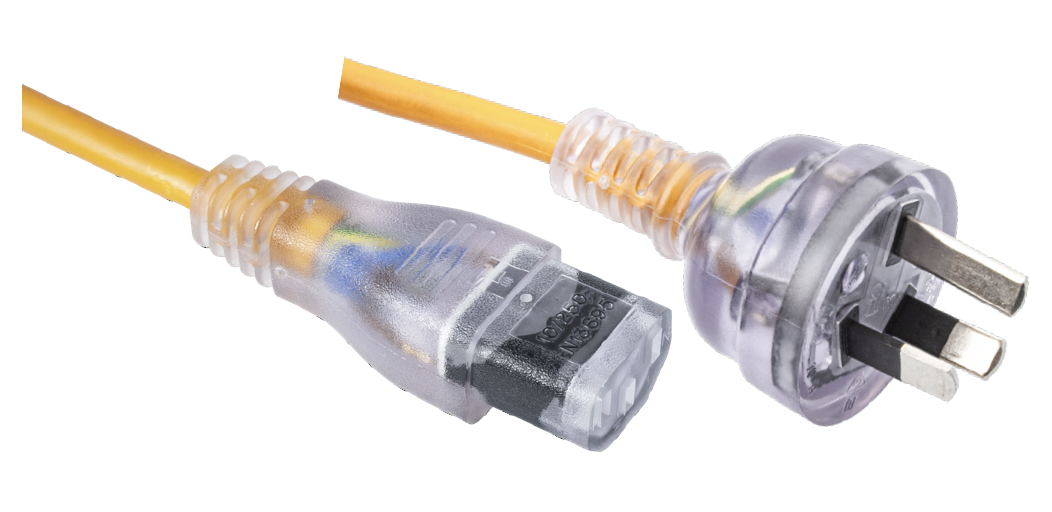 |
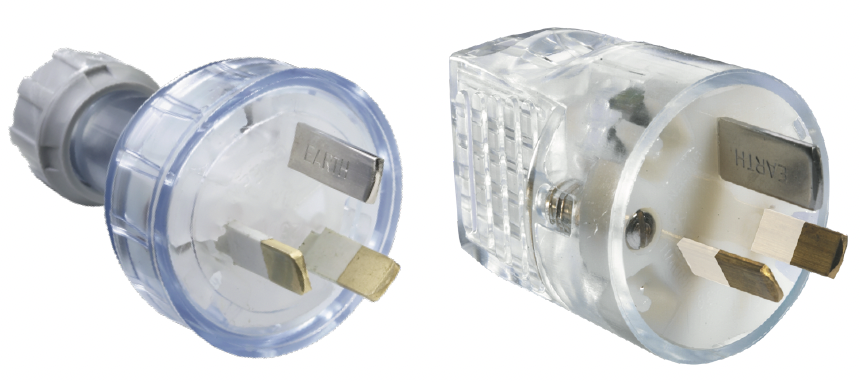 |
Danish hospital-grade cords, plugs, and sockets in medical applications are under the SB 107-2-D1 requirements. The socket is designed to prevent non-hospital-grade plugs from connecting and disrupting the main circuit in medical settings. The preferred color for hospital-grade cord sets in Denmark is red.

In Japan, cord plugs and sockets must carry the PSE approval mark under DENAN, a Japan Ministry of Economy, Trade and Industry (METI) mandate. Noteworthy is that Japan has two frequencies. The Fuji River is used as a geographical reference point for the two frequencies: on the eastern side (Tokyo, Yokohama) 50 Hz is used; on the western side (Osaka, Kyoto, Hiroshima) 60 Hz is used. Europe mainly uses 50 Hz, and the U.S. uses 60 Hz. Typically, frequencies aren’t mentioned in the standards, whereas an emphasis is put on amperages and voltages.
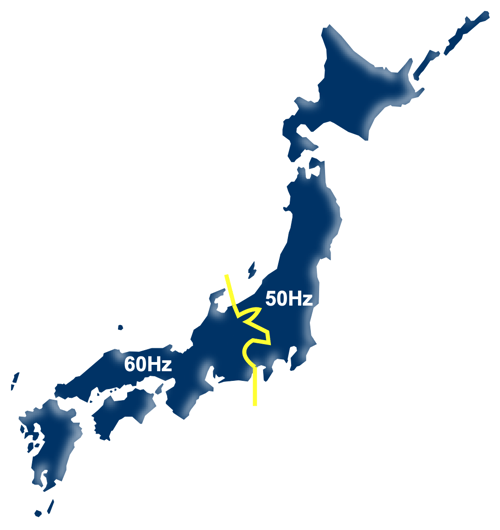
The EN 60601 is the Medical equipment standard for European countries. Non-European countries follow the IEC 60601-1 medical standard (except for China, Korea, and Japan). There are over 100 medical equipment standards in IEC 60601. The most general and inclusive is IEC 60601-1. Subsequently, IEC 60601-2 through IEC 60601-118, focus on individual medical equipment and apparatus.
Cords Like Crash Test Dummies?
The UL 817 Abrupt Removal Test is one example of strenuous hospital-grade cord testing. A plug is plugged into a socket. The wire from the hospital-grade plug is attached to a 10-lb weight which is then dropped to abruptly disconnect the plug from the socket to see how far the blades have bent, and to see if the wires have lost electrical continuity.
The Abrupt Pull Test is a test standard NEMA plug/cord (3-conductor cords) test, including hospital-grade cords. A 2 ½ pound weight is attached to the plug’s cord and dropped 25 times from the connected plug and socket. Before the initial drop, three lights on the test equipment glow red showing electrical continuity. However, during the test, if one of the three wires fail (line, neutral, and ground) and one or more lights go out, the test is considered a failure. If that occurs, the plug is examined to see why the continuity was broken.
Hospital-Grade Cords Made Safer? Cord Clips!
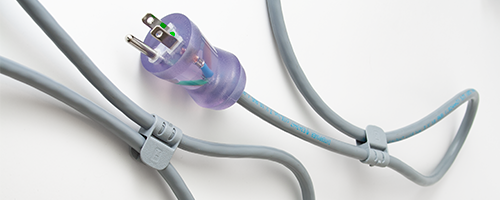
Despite the universe of resin compounds listed on UL’s website, sometimes finding the perfect resin with the right additives is challenging, especially when mixing resin compounds with nonresinous material. Interpower’s cord clip can be molded onto 3 x 16 and 3 x 18 AWG cords as well as the 3 x 18 VCT-F Japanese cords, and is constructed of a glass-reinforced Polypropylene resin compound to ensure molding consistency and optimal retention.
“To strike a balance between cord retention strength and ease of insertion force,” Mike Winders, Interpower Product Development Specialist said, “we utilized customer surveys to determine the correct material and product design that would meet their needs.” The clip is set at a convenient 4.75 inches behind the plug as an optimal distance after much experimentation and testing. The clips come in gray and black and are made in the U.S.A.
Cord clips help prevent injuries—less cord to trip over, less stress on hands, arms, and back from pulling and holding the weight of slack cord. It also extends cord life by keeping it away from machinery and tools, and preserves the jacketing by allowing less drag. It also minimizes the chance of excess cord catching on objects and surfaces, which may cause disconnections or bent plug blades.
The cord clip resin is considered a stable thermoplastic with no chemical reactivity under normal ambient or anticipated temperatures and pressures. Interpower cord clips can be used in a wide range of markets such as Industrial, Information Technology, Appliance, Medical, Food Service—anywhere excess cable could pose an issue or a danger.
Topics: electrical safety, Hospital-Grade Products, North American Hospital-Grade Cords, cord clips, Japanese Hospital-Grade Cords





